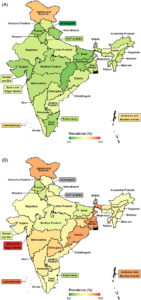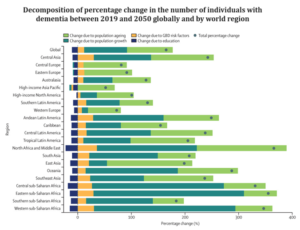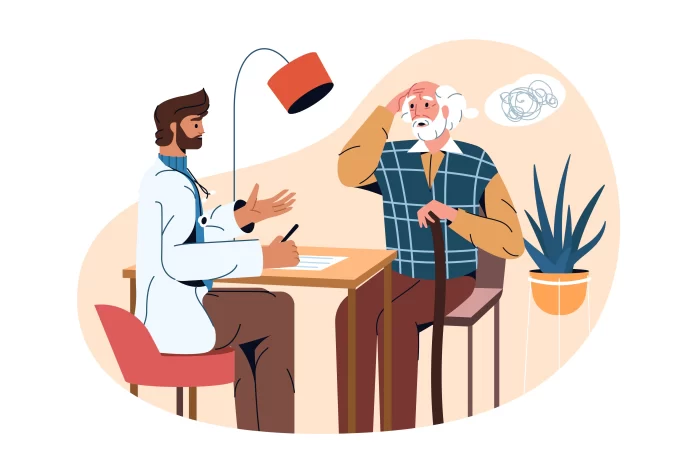“Dementia is a complex condition, one that is not easily understood or explained. It is a disease of the brain that takes away memory, language, and ultimately, identity,” emphasized Maria Shiver, former First Lady of California and the founder of NGO, The Women’s Alzheimer’s Movement. Stereotypically “dementia” evokes the image of old people with fading memories, tangled thoughts & slow descent into darkness. However, while it mostly affects mostly older people, it is not simply related to the natural consequence of ageing. It involves complex aspects of neurological changes which affect the patients and is important to understand for the caregivers.
Important Statistics:
A longitudinal ageing study conducted by Lee et al. (2023), found that 7.4% of adults over 60 years of age in India are estimated to have this diseases. Thus, nearly 8.8 million people in India, above the age of 60 years of age are suffering from dementia. Lee et al. (2023), also found that, In India it is more prevalent among females as compared to men. Researchers also observed significant cross-state variations in the prevalence of dementia.
![Age-specific dementia prevalence rates by sex, urbanity, and education. A, Mean age-specific dementia prevalence rate by sex (95% confidence interval [CI]). B, Mean age-specific dementia prevalence rate by education (95% CI)](https://shareyouranxiety.in/wp-content/uploads/2024/01/2-203x300.jpg)

Globally, 55 million people are suffering from this diseases and almost 60% of those people live in low- and middle-income nations (WHO.int, 2024). Worldwide, It is the primary cause of disability and dependency among the old people. A Lancet study by Nichols et al. (2022) estimated that these cases will rise up to 152.8 million by 2050. Countries belonging to north-Africa, the Middle East and sub-Saharan Africa will witness the highest increase in the cases.

Dementia Clinical Manifestations:
There are various underlying conditions which can point towards the clinical manifestations or outward expressions of dementia. The most common forms includes Vascular dementia, Dementia with Lewy bodies, Frontotemporal dementia and Mixed dementia (Dening & Sandilyan, 2015). The less common conditions which can manifest includes; Huntington’s disease, Corticobasal degeneration, Creutzfeldt-Jacob disease, Multiple sclerosis, Normal pressure hydrocephalus and HIV-related (Dening & Sandilyan, 2015).
How Do You Get Dementia:
It is caused when there is damage or loss of nerve cells and their connections in the brain. The symptoms related to the disease are based on the area of the brain damaged. Different people are affected differently. There are several risk factors associated with dementia. Age, family history and Down syndrome are risk factors that can’t be changed. Risk factors that can be managed include; diet and exercise, alcoholism, Cardiovascular risk factors, depression, air pollution, etc (Schwertner et al., 2022).
Dementia Disease Symptoms:
It is an umbrella term for various neurodegenerative diseases which primarily result in the disruptions of brain function. These disruptions manifest in a decline in cognitive abilities which affects memory, thinking and reasoning. It was described as cognitive degeneration in earlier times Aberrant motor behaviour, agitation/aggression, and irritability are the most common disease symptoms among patients of Alzheimer’s disease (AD), mixed dementia, and vascular dementia (VaD) (van der Linde et al., 2016). Symptoms of dementia with Lewy bodies (DLB) and Parkinson’s disease dementia (PDD) are delusions, hallucinations, agitation, anxiety, irritability, and aberrant motor behaviour. The most common symptoms in the case of Frontotemporal dementia (FTD) are aberrant motor behaviour, agitation/aggression, irritability, and apathy (Schwertner et al., 2022).
Treatment:
There is no specific treatment for curing it. The only way is to manage the symptoms and improve the quality of life of the patients. Two main types of medications used are; Cholinesterase inhibitors and Memantine. Cholinesterase inhibitors increase acetylcholine which might help to form memories and improve judgment (Leonard, 2023). It also delays the onset of Alzheimer’s disease. Memantine delays the onset of cognitive and behavioral symptoms. Various non-drug therapies, such as modifying the environment and common tasks through occupational therapies, also manage complications associated with the disease. (Clevelandclinic.org, 2024).
Dementia and Gut-Brain Axis:
Multiple research studies indicated that gut microbiota has a crucial role to play in the development & progression of the disease. Individuals with inflammatory bowel disease have a comparatively higher likelihood of receiving a diagnosis. (Sun et al., 2022). Further microbiome-gut-brain axis has also emerged as a crucial diagnostic and therapeutic target for it. The gut bacteria of people with the disease are also different from typical people. It’s patients have a higher presence of pro-inflammatory bacterial strains which cause the development of amyloid plaques in the brain (Saji et al., 2020).
Conclusion:
Understanding dementia is the first important step to developing an effective care strategy for people facing dementia. Patients suffering from dementia require a compassionate care policy that embraces the latest research and comprehensive care. The latest research findings on the gut-brain axis along with modern management open doors for new possibilities.





